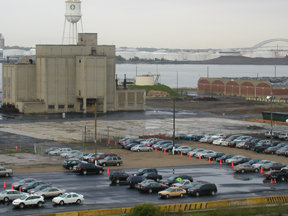In what may portend a major change in the direction of development at the former Military Ocean Terminal of Bayonne, the City Council voted at a special meeting on Jan. 25 to ask the Planning Board to study the possibility of developing the Harbor Station district for commercial uses.
Harbor Station is the westernmost district of the MOTBY area. A 102-acre site along Route 440 near the New Jersey Turnpike and the Hudson Bergen Light Rail Station, it is considered the gateway to the rest of 432-acre MOTBY.
The original redevelopment plan called for a mixed use of low to mid-rising housing, neighborhood retail, office space, and entertainment and civic facilities. But that may change.
“I think this tax bill is good news for the city.” — Terrence Malloy
________
Last year, Fidelco tried to amend its agreement to construct rental units rather than for-sale homes, and filed suit against the BLRA when the BLRA refused to amend the contract.
BLRA Executive Director Chris Patella said an agreement to settle the lawsuit is close to being signed, and that the BLRA would like the Planning Board to look into a commercial plan that might allow Harbor Station to be developed in a new direction, shying away from residential development in favor of a concentration on commercial, retail, and other such uses.
“This would give us some options,” he said, noting that since the first agreement with Fidelco, the housing market has declined sharply.
The Planning Board would issue a report to the council in February, and the matter would be brought up for a review at the Feb. 17 City Council meeting.
February tax bills will be lower than last quarter
With the third quarter tax bills set to go out in early February, City Business Administrator Terrence Malloy said at the Jan. 20 council meeting that these will be on the average $35 lower than the bills that went out in each of the first two quarters of the 2009 FY budget.
“I think this tax bill is good news for the city,” said Malloy.
Although the first three quarters are based on estimates, he believes overall that the annual city budget, when passed some time in April or May, will reflect significant efforts to control costs and will pretty much remain the same as last year’s tax bills or moderately lower.
While the city is facing a huge hit on tax appeals this year, Malloy said he believes the impact will be far less than the $5 million sought by taxpayers in the city.
He said many will still have to be reviewed, some will even be settled for less, and what the city has to pay can be paid through a bond that can be spread out over a number of years.
The city is also facing $4.5 million in pension payments, some of which were accrued from last year when the city was allowed to opt out of paying it. But Malloy said the city has several means of offsetting this cost that will allow it to avoid increasing the budget this year.
Public pensions are tied into the stock market. As a result of agreements with municipal unions, municipalities are obligated to fund the pensions if the stock market investments fail to meet pension expenditures. Since the stock market has been down, Malloy said, municipal obligations to the pensions have risen.
‘Junk yard’ restriction kept
In a divided vote, the council narrowly defeated a move that would have removed a land use restriction from a car exporter at 63-64 New Hook Road.
In 1965, the city – in an effort to do away with unsightly junk yards – banned them for that area. A new owner of the property, which exports cars, asked the city to lift the restriction, saying that the operations did not include long term storage or sale of parts.
While councilmen Gary La Pelusa and John Halecky voted to lift the restriction, Council President Vincent Lo Re joined councilmen Terrence Ruane and Ted Connolly in keeping the restriction in place.
Lo Re, citing a report issued by city planner John Fussa, said that the facility operations did not fit in with the master plan and the proposed upgrade of business and light industry uses for the area.
Ruane said that while the facility might not be a junk yard, many of the vehicles stored there were rusty and in disrepair, giving a negative appeal to an area that will soon have a shopping mall and other more upscale businesses.
La Pelusa and Halecky, however, said their vote was based on the fact that the facility provides jobs in the area.
Council also passes property maintenance ordinances
Meanwhile, the City Council at its Jan. 20 meeting unanimously approved a group of ordinances designed to improve property maintenance and to crack down on illegal apartments. An illegal apartment is any apartment that lacks a certificate of occupancy, which requires it to meet certain safety requirements.
Landlords caught renting illegal apartments could face find up to $750 per day and up to 10 days in jail for first offenses. They would also be required to pay at least $500 and as much as six months worth of rent to the city’s Relocation Assistance Fund for each illegal unit.
The council also voted to adopt international codes of maintenance that would help supplement the city’s existing codes. In the past, the city developed codes as they saw the need. The new rules would fill in the gaps in the law, any area which the new code does not cover. Existing municipal codes would apply, city officials said.
